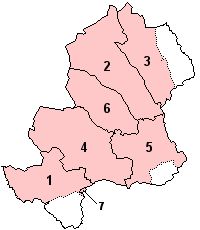The Preserved county of Mid Glamorgan is divided into 6 parliamentary constituencies, one of which is shared with Gwent. The current boundaries have been effective since the 2007 National Assembly for Wales election and the 2010 United Kingdom general election.[1]
Constituencies
[edit]| Name | 1997 to 2010 | From 2010 |
|---|---|---|
* pre-2010 parts coloured white were included and were in South Glamorgan |
 |
 |
Conservative † Labour ‡
| Constituency | Electorate | Majority | Member of Parliament | Nearest opposition | Map reference above | ||
|---|---|---|---|---|---|---|---|
| Bridgend CC | 63,303 | 1,157 | Jamie Wallis † | Madeleine Moon ‡ | 1 | ||
| Cynon Valley CC | 51,134 | 8,822 | Beth Winter ‡ | Pauline Church † | 2 | ||
| Merthyr Tydfil and Rhymney CC (western part is in Mid Glamorgan) | 56,322 | 10,606 | Gerald Jones ‡ | Sarah Jones † | 3 | ||
| Ogmore CC | 57,581 | 7,805 | Chris Elmore ‡ | Sadie Vidal † | 4 | ||
| Pontypridd CC | 60,327 | 5,887 | Alex Davies-Jones ‡ | Sam Trask † | 5 | ||
| Rhondda CC | 50,262 | 11,440 | Chris Bryant ‡ | Hannah Jarvis † | 6 | ||
Proposed boundary changes
[edit]The Boundary Commission for Wales submitted their final proposals in respect of the Sixth Periodic Review of Westminster Constituencies (the 2018 review) in September 2018. Although the proposals were immediately laid before Parliament they were not brought forward by the Government for approval. Accordingly, they did not come into effect for the 2019 election which took place on 12 December 2019, and which was contested using the constituency boundaries in place since 2010.
Under the terms of the Parliamentary Voting System and Constituencies Act 2011, the Sixth Review was based on reducing the total number of MPs from 650 to 600 and a strict electoral parity requirement that the electorate of all constituencies should be within a range of 5% either side of the electoral quota.
On 24 March 2020, the Minister of State for the Cabinet Office, Chloe Smith, issued a written statement to Parliament setting out the Government's thinking with regard to parliamentary boundaries. They propose to bring forward primary legislation to remove the statutory obligation to implement the 2018 Boundary Review recommendations, as well as set the framework for future boundary reviews in time for the next review which is due to begin in early 2021 and report no later than October 2023. It is proposed that the number of constituencies now remains at the current level of 650, rather than being reduced to 600, while retaining the requirement that the electorate should be no more than +/- 5% from the electoral quota.[2]
See also
[edit]- List of parliamentary constituencies in Wales
- List of parliamentary constituencies in West Glamorgan for historical representation by party for the whole of Glamorgan
The implemented Fifth Periodic Review of Westminster constituencies.
References
[edit]- ^ The Parliamentary Constituencies and Assembly Electoral Regions (Wales) Order 2006, OPSI website
- ^ "Update: Strengthening Democracy:Written statement - HCWS183". UK Parliament. Retrieved 21 April 2020.